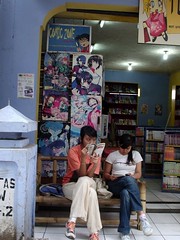by Maura McKee and Emily BarneyGraphic novels have won awards in many categories, including a Pulitzer Prize for Art Spiegelman’s graphic novel
Maus: A Survivor’s Tale, a memoir of his father’s survival of the holocaust.
¹ There are also many awards dedicated just to comic books by genre or for achievement in specific fields.
The Hahnl Library's
Comic Book Awards Almanac includes a
glossary that explains the differences between these awards, from festival awards to nominations, polls and special selection awards.
You can find more information about the different awards on specific pages on
Wikipedia including "
Comic Book Awards," "
Anime and Manga Awards" and "
Award-Winning Graphic Novels"
Examples of awards given in this field:- Harvey Awards - http://www.harveyawards.org/
- This series, named after writer artist Harvey Kurtzman, includes awards for achievement in writing, art, humor, letterer, colorist, new talent, etc. with comic books.
- Ignatz Awards - http://www.spxpo.com/ignatz.shtml
- Named for the character in the classic comic strip Krazy Kat by George Herriman this is a festival prize that recognizes outstanding achievement in comics and cartooning with special prizes in ten different categories.
Examples of other award winning graphic novels: American Born Chinese,
American Born Chinese, a graphic novel by Gene Luen Yang won the 2007 Michael L. Prinz Award for literary excellence in young adult literature. The novel interweaves three different stories:
one is a folk tale of "The Monkey King", another is the story of a second-generation immigrant named Jin Wang, and the third is about Danny, a boy with a Chinese cousin named Chin-Kee. The book's climax merges all of these stories together.
More information about the author and the series is available at:
http://www.humblecomics.com/
Jeff Smith's
Bone is the longest-running self-published series so far and has won more awards than any other comic in history. It began with the whimsical adventures of Phone Bone and developed into an intricate world with monsters and dragons waging war against the forest creatures under the leadership of a cow-racing grandmother. It was released between 1991 and 2004, as 55 irregularly-released issues that were printed in 9 individual volumes and eventually gathered into one major volume, pictured here. This series has won 44 awards in America and around the world, including 10 Eisner Awards and 11 Harvey Awards.
²More information about the artist and series is available at
http://www.boneville.com/
Harvey Pekar and his wife Joyce Brabner wrote
Our Cancer Year as he dealt with the discovery of his lymphoma and its treatment. The book was illustrated by Frank Stark, an award-winning professor of art at the University of Missouri. This volume won the 1995 best graphic album Harvey Award. Pekar had already won the American Book Award in 1987 for his American Splendor series. Pekar's life story
-- including how he met and married Joyce Brabner, and how he experienced cancer and its treatment
-- was made into an excellent film, American Splendor (2003).
³More information about the author and other graphic novels by him and his wife are available at
http://www.harveypekar.com/
Linda Medley's
Castle Waiting was in YALSA's 2007 Top Ten Great Graphic Novels for Teens, and Booklist's Top 10 Graphic Novels for Youth. It has also won 2 Harvey Awards and 7 Eisner awards, including the 1998 Best New Series Eisner Award. Medley began the series in 1996 and volume one was published in 2006. The series begins with a short retelling of the Sleeping Beauty fairy tale, but once she has left for her happily ever after the castle becomes a refuge for marginal fairy tale creatures and characters, telling stories of unconventional convents and enterprising uses of the goose who laid the golden egg.

Don Rosa's Life and Times of $crooge McDuck explains how the "richest duck in the world" won his fortune between 1877 and 1947. This historical fiction follows his adventures from Scotland to America and beyond to the African Transvaal, Australia, and the Klondike, encountering figures like Theodore Roosevelt. Published from April 1994 to February 1996, it won the 1995 Eisner Award for Best Serialized Story and the 1995 Comic Buyers Guide Fan Awards for Favorite Comic Book
More information is available about the series on Don Rosa's "
The IntroDUCKtion to the Life and Times of $crooge McDuck"
² "The History of BONE & Jeff Smith" http://www.boneville.com/bone/bone-history/
³ Kohn, Martin "Brabner, Joyce and Pekar, Harvey: Our Cancer Year" Literature, Arts & Medicine Database 14 April 2005 http://litmed.med.nyu.edu/Annotation?action=view&annid=383














